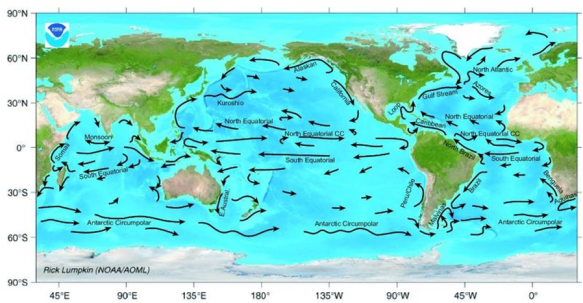| inbluevt | Date: Sunday, 2013/07/21, 12:43 PM | Message # 1 | DMCA |
|
|
Private
Group: Blocked
Messages: 1024
|
By the time I was an oceanography student in college (UICC for you Chicago people out there), geologists had finally worked through the controversial debate of Alfred Wegener's theory of continental drift (first proposed in 1912): now accepted and in the textbooks. For most kids that look at a world map and think that South America and Africa look like they belong together, continental drift was not such a shock. But for me finding out about the oceans was and that continues to this
day.
When we think of oceans, any oceans, old and new, the same image always comes to mind: some shade of blue, wildlife of some sort, and made up of familiar H2O. That H2O is the chemical definition of water. But as the climate changes (as it has in the past), the sea chemistry also changes and the oceans we know now would be unrecognizable to us in those different periods. As we continue to
pump CO2 into the atmosphere, and much of that is captured in the oceans, we are slowly changing that chemistry: the oceans are becoming more acidic. And that change in ocean chemistry threatens the very existence of all life on earth.
The following articles will talk about the different kinds of oceans scientists have discerned and
how life would be, or not be, with them. There are three main ocean types: mixed (or layered like the modern Black Sea), ours now (pretty much oxygenated top to bottom maintained by the conveyor system) and Canfield (poisonous and dominated by the presence of hydrogen sulfide, H2S, and
the purple bacteria, pictured below, that live there).
The first look (caps are mine):
Quote (and now) To the North Atlantic, to see the conveyor system. In the 21st century, it had stopped, for some decades, and Europe had indeed cooled. The alarmists had predicted quite wrongly that Earth was finally sliding into the much overdue ice part of the ice ages, but this cooling was regional to Europe and short; the rocketing CO2 levels saw to that, shooting well past any chance of a global glaciation as so often happened over the last two million years. But the conveyor had not stayed shut down for long; now it was chugging away, but in a far different geography than before. The superheated warm water of the tropics headed north as before, but the sinking happened well south of its original Greenland location. Now the vast quantities of water
slightly cool while heading north and sink in the mid-latitudes, and the water sinking is very different from the cold, oxygenated water of before. This is the warm water that no longer can sink to the abyss, and the thus the delivery of oxygen to the bottom has stopped. THE DEEP
OCEAN IS NOW A GRAVEYARD, WARM DEADLY WATER BATHING SPECIES THAT HAD EVOLVED AND ADAPTED FOR SOMETHING QUITE DIFFERENT, AND THE START OF THE MASS EXTINCTION IS UNDER WAY. The ocean is returning, rapidly, to its most common ancient state, the ANOXIC state, and already poison is accumulating on the bottom, hydrogen sulfide concentrating, year by year.
The above is a quote from the very readable book "Under a Green Sky: Global warming, the mass extinctions of the past, and what they can tell us about our future", by Peter Ward, which I highly recommend reading. The contents of the quote itself comes from Dr. Ward's interview with Prof. David Battisti about what he sees the ocean of the future looking like. The view was based on the Eocene ocean and CO2 levels at 800 ppm. As a reminder, we have passed the halfway mark, with little slowing in view. The theory, now being debated favorably, is that the change in the chemical content of the oceans ultimately led to thePermian mass extinction. (At that time, the CO2 levels were 3,500 ppm.)
2. Video: ocean acidification short: clear explanation, but not an action movie
3. Article: An early productive ocean unfit for aerobics

PHOTO DESCRIPTION: A modern analog for the ancient sulfidic ocean? (Upper) Mahoney Lake, British Columbia, Canada—perhaps like the Proterozoic ocean (2)—contains abundant H2S in the photic zone. In the case of Mahoney Lake, the O2–H2S interface is only 7 m deep—ideal conditions for anoxygenic photosynthesis. (Lower) A “plate” of profuse purple, S-oxidizing, anaerobic bacteria at this
interface generates more than half of the primary production in the lake. (Lower photo by J. Glass, Arizona State University, Tempe, AZ.)
THE ARTICLE BEGINS:.Grasping the big picture of the early ocean used to be easy: no oxygen, and then oxygen. The crux of that popular model hinged on the almost universally accepted Great Oxidation Event, or GOE, during which appreciable free oxygen (O2) first accumulated in the atmosphere about 2.4 billion years ago. At the same time, as the old argument goes, the O2-free, iron-rich earlier ocean gave way to one with oxygen at all depths. About a decade ago, Canfield (1) offered a very different possibility—that ventilation of the deep ocean lagged behind the GOE by more than a billion years, resulting in a vast, deep reservoir of hydrogen sulfide, but long-held presumptions about photosynthetic life in the surface waters remained untouched. In the first comprehensive biogeochemical model of this “Canfield Ocean,” Johnston et al. (2) in a recent issue of PNAS present a stunningly different take on those early photosynthesizers—one in which the upper, light-containing layers indeed drove biological production but without the expected concomitant release of oxygen. And it is this feedback
that may explain a troubling uncertainty about the Canfield Ocean and this time interval in general—exactly how oxygen in the biosphere remained at only a fraction of modern levels for so long after the GOE.
Complete article
4. Article: When the Party’s Over: Permian Mass Extinction
The largest mass extinction on earth occurred approximately 251million years ago at the end of the Permian geologic era. Almost 95% of all ocean species and 70% of land species died, and research has shown that what probably happened to cause this extinction was carbon dioxide levels.
As the saying goes; those who do not learn from history are doomed to repeat it, so let’s see what happened to the planet 251 million years ago and work out how we humans can avoid doing it to ourselves at high speed.
This research paper from 2005 did the first comprehensive climate model of the Permian extinction, which means their model was complicated enough to include the interaction between the land and the oceans (as different to ‘uncoupled’ models that just looked at one or the other and not how they affected each other).
The researchers used the CCSM3 climate model that is currently housed at the National Centre for Atmospheric Research (NCAR) and is one of the major climate models currently being used by the IPCC to look forward and model how our climate may change with increasing atmospheric carbon pollution (or emission reduction).
They organised their model to have ‘realistic boundary conditions’ for things like ocean layers (25 ocean layers for those playing at home), atmospheric resolution and energy system balance. They then ran the simulation for 900 years with current conditions and matched it with observed atmospheric conditions and got all of their data points correct with observed data.
Complete article

Ocean currents
Message edited by inbluevt - Monday, 2013/07/22, 6:42 AM |
|
|
| |

 Main
Main  Forum
Forum Registration
Registration Login
Login